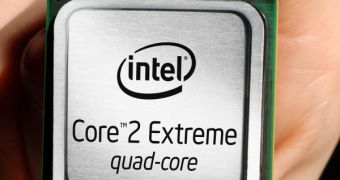Intel's 45-nanometer desktop quad-cores are still hard to find at the retailers' stores, but the company claims that it is on schedule with ramping up its 45-nanometer production at its fabs. During yesterday's conference call, the company said that it expects shipment volumes of products made using 45nm and 65nm fabrication technologies to crossover during the third quarter of the year.
"I did show that slide at the investor meeting and it shows a crossover [between 45nm and 65nm chips] in the third quarter and we are still on track to that and we are ramping as fast as we can," said Intel's Senior VP and chief executive, Paul Otellini. "At this point in time, we've shipped in excess of 8 million units, so we are moving very quickly up the ramp curve," he continued.
It seems that Intel is currently working at full capacity in its two 300-millimeter fabs equipped with 45-nanometer processing technology. The two fabs are the D1D facility located in Hillsboro, Oregon, and the famous Fab 32 in Chandler, Arizona.
However, the two processing units are also delivering the Xeon server parts that face increased demand on the market, and Intel plans to open this year two additional units in Kiryat Gat, Israel (Fab 28) and Rio Rancho, New Mexico (Fab 11x).
The 45-nanometer transition would allow the chip manufacturer to produce its Intel Core 2 Duo and Quad CPUs at lower costs, thus lowering the average price per unit at its channel partners. More than that, after the transition is complete, Intel will be able to fully focus on its next micro-architecture, also known as the Nehalem silicon.
Intel is expected to move more than 50 percent of its production to the 45-nanometer micro-architecture until the end of the third quarter, which would result in faster, better and more energy efficient chips, which could become a serious issue for its Arch-rival AMD.
"Our first quarter results demonstrate a strengthening core business and a solid global market environment. We saw healthy demand for our leading-edge processors and chipsets across all segments. Looking forward, we remain optimistic about our growth opportunities as we continue to reap the benefits of our 45nm technology leadership," concluded Otellini.

 14 DAY TRIAL //
14 DAY TRIAL //